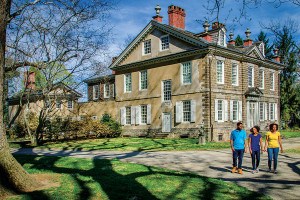King of Prussia Moves to Put the “Urban” in “Suburban”

The King of Prussia District covers the areas shown on the map above. Image | ConnectKOP.com
“King of Prussia is a suburban community and it will remain a suburban community.”
So said Eric Goldstein, executive director of the King of Prussia District, when we spoke about the currents of urbanity that flow through the business improvement district’s latest “Report to the Community.”
Those currents are there, however, because the district can see the writing on the wall. Or, more accurately, the footsteps on the sidewalk.
And what that means is that, much like its well-known counterpart outside Washington, Tysons Corner, the biggest edge city north of Tysons is giving itself injections of urbanity in hopes of attracting a new generation of businesses and workers.
“The business improvement district was founded in 2010, and it’s always been a goal of the district,” he said. “While people still want to live and work in suburban communities, they are looking for communities that are more dynamic and more stimulating.”
Thus the district has been working to retrofit—”the word I use is reposition,” said Goldstein—both its office and its retail sections with the sort of walkable, mixed-use physical environments many Millennials prefer, even those who prefer suburbia over city districts.
The first, most crucial step involved getting Upper Merion Township to rewrite its zoning code to allow mixed-use districts and more compact development around future transit stations. It did not only that, but also approved a new development ordinance that raised the bar for construction materials and quality and promoted pedestrian-friendly, transit-supporting development. Both changes took place in 2014.
The district then began working on the transit, first launching The Connector shuttle bus service between the King of Prussia business park and nearby SEPTA rail stations. Its bigger push for better transit is now in progress with the Norristown High-Speed Line spur to the King of Prussia malls and office park.
Then it began promoting this new version of Philadelphia’s biggest edge city to developers and businesses. The result is the current construction boom in the area, described in detail in the report. In 2014, the report states, 196,504 square feet of non-residential space was built in King of Prussia, and the pace has accelerated since; according to the district, 350,000 square feet of non-residential space is on track to be added in the years ahead. On top of this, 415,000 square feet of new retail space will come on line this year in the form of the new connector between the Court and the Plaza at King of Prussia and the new King of Prussia Town Center.
The Town Center will also have something not seen before in a King of Prussia commercial project: Residents. The center will add to several existing stores a new mixed-use Main Street-style component called the Village at Valley Forge, which includes a luxury apartment building, Indigo 301. Meanwhile, over in the business park, a former office building is being converted into apartments as well; between the Town Center and the business park, 1,700 new apartments are being added to King of Prussia’s housing stock, which will boost the resident population of the area above its current level of just under 30,000. The residential projects are the first new housing in King of Prussia in 15 years.
“I don’t think anyone can argue the fact that King of Prussia is experiencing unprecedented development today, the most development King of Prussia has experienced in recent memory,” Goldstein said. Projects now under way represent more than $1 billion worth of economic development.
More, and more reshaping, is to come as well. Plans call for First Avenue, the main thoroughfare in the business park, to be put on a “road diet” to make it more pedestrian- and bicycle-friendly, and the district also plans to add a “linear park over the next two to three years that would connect all the properties in the business park via greenery. More revisions to the Upper Merion zoning code are also being worked on.
But “the number one project in our mind,” Goldstein said, “is to get the rail extension built. King of Prussia needs rail service. It will allow our communities to be more walkable, to develop in a more sensible way, and reduce congestion on the roads.”
King of Prussia is already the largest employment and shopping center in the Philadelphia suburbs and second only to Center City in the region as a whole. The development under way and on the boards will strengthen that status.


